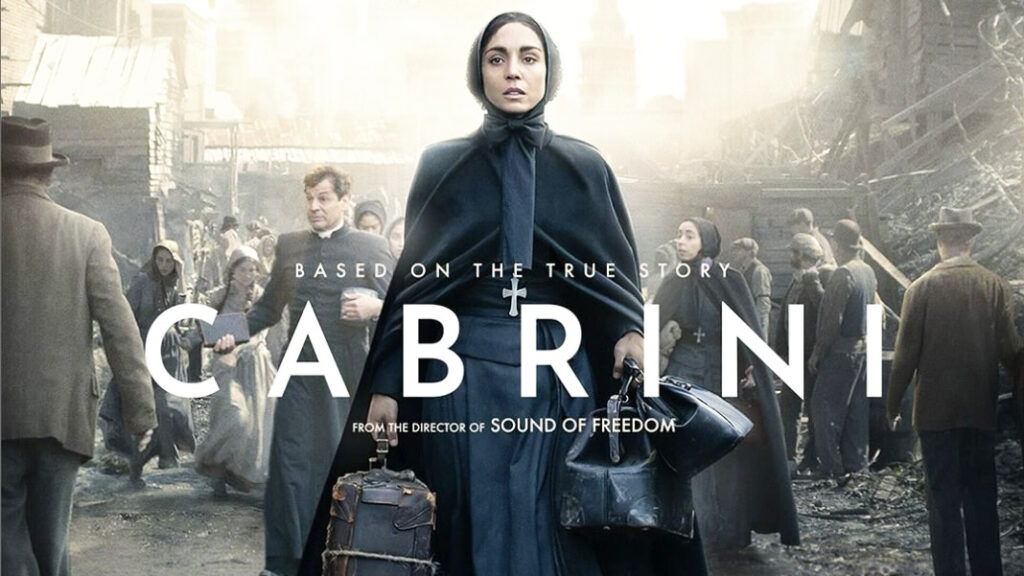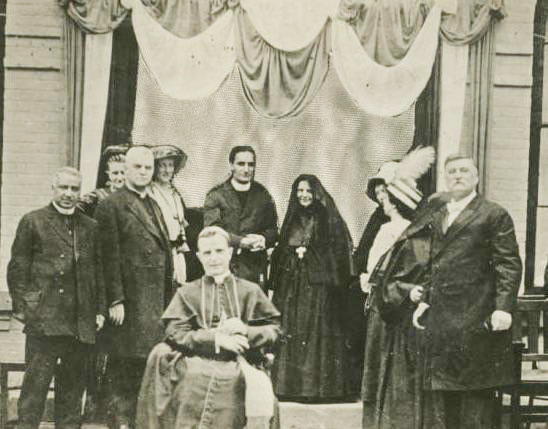“Nevertheless, she persisted.”
This modern-day feminist phrase became a national sensation at the 2017 attorney general confirmation hearings for Senator Jeff Session, who found himself the subject of Senator Liz Warren’s wrath. Afterward, Senator Mitch McConnell, rising to Session’s defense, dismissed Warren’s concerns as an (alleged) example of feminine caterwauling. To say that American women were not amused is an understatement. Instead, they turned the phrase on its head, morphing its condescension into a call for fierceness.

Yet more than a century-and-a-half ago, a frail, yet determined, Roman Catholic nun from Codogno, Italy embodied that statement physically, emotionally, and spiritually. Maria Francesca Cabrini, aka Mother Cabrini (she added the “Saverio/Xavier” after taking religious orders), was the 19th century founder of the Missionary Sisters of the Sacred Heart of Jesus who never backed down in her quest for social injustice, particularly in America. She truly didn’t take no for an answer, whether it was from Pope Leo XIII, an Irish American archbishop, or the Anglo mayor of New York.
The new film Cabrini is a labor of love by Mexican director Alejandro Gomez Monteverde, the socially committed filmmaker whose films Bella (2006) and Sound of Freedom (2023)–about abortion and sex trafficking, respectively—speak to his concerns. A committed Catholic, Monteverde admitted to a reporter, to his embarrassment, that he never really knew much about Cabrini. He did know that, in 1946, she was the first American to be canonized a saint in the Church, but that was about it. His biopic seems meant to correct that historical amnesia with a vengeance. Like Cabrini, he is relentless.
And, happily and luckily for Italian Americans, Monteverde’s cinematic skills dignify our struggles with full-scale production values rarely employed in Hollywood or elsewhere. The sets, costumes, and cinematography are top-notch (despite being a bit posed and at a remote). And then there is the very important aspect of empathy: With the exception of a vicious pimp in the film named Geno, the Italians are seen as human beings worthy of dignity, not thuggish caricatures (male) or gum-chewing bimbos (female). The genuine suffering of our immigrant forebears is respected.
(Indeed, the image of Cabrini and her small group of nuns walking together in unison, their flowing black robes nearly blending into a single form, like a female Roman legion, might have put the fear of God into any neighborhood gangster. The power of good, indeed. Marvel Comic filmmakers, take note!)
The script by Rod Barr follows Cabrini’s life from age 38 to 41, when she made her first trip to America in 1889 at Pope Leo XIII’s urging; he told her to “go not to the East, but to the West”; (Cabrini had originally wanted to do missionary work in China; in 1927, ten years after her death, her sisterly Order accomplished that feat).
The pope was concerned about the millions of poor, mostly southern Italians who had begun migrating to America due to poverty and disease and natural disasters. He thought they might have felt abandoned. Sadly, he was correct: Not only had Italy failed them but America ignored them, treating them as human waste. The immigrants lived in the Five Points district in New York, an area as bleak and desolate as any industrialized ghetto in England.
Cabrini made it her mission to cater to these abandoned people, particularly the young orphans. Armed with nothing but Italic pragmatism and good, old-fashioned American pluck, Cabrini shamed politicians (both here and in Italy), lobbied philanthropists, and never, ever stopped radiating love and compassion. The filmmakers may have underplayed her devotion to Jesus in order to make her palatable to modern audiences or other religions (we barely even see her pray in the movie); but, as Eustace Wolfington, the film’s executive producer, has said, such trappings weren’t really needed as “Cabrini’s entire life was a sermon.” And not a preachy one. Cabrini, like many other Italian women religious before her—e.g., Catherine of Siena, who tirelessly worked to heal a breached papacy during the Great Schism from 1378-1417—simply saw what needed to be done and did it.
So does Monteverde, though at times he overdoes it. There are some genuine grace (no pun intended) notes, such as clever editing shifts while the camera moves, but he has a tendency to call attention to his work. A long-shot of a female orphan being buried, for example, shouldn’t be framed to suggest a pretty religious chromo, with water in a park passageway acting as a mirror image of the burial. Too pretty for such a stark scene. A filmmaker like the great Vittorio De Sica would’ve eschewed such showing off. What mattered to De Sica was the emotion. We would have felt the girl’s death.
Similarly, the musical score follows the Hollywood parabola of rising and swelling, telling us when to cry, when to cheer, etc. Again, less is more. That said, there are two scenes in the film where Italian music is used simply and unobtrusively. And guess what? The audience cries. The tears are earned.

New York power brokers, 1914
(Photo: Cabrini Shrine)
As for the thankless role of playing a saint, the Italian actress Cristiana Dell’Anna shows the patience of one, as well as that of a dedicated actress. Like Cabrini, she, too, persists. Midway through the film, Pope Leo (the great 1970s actor Giancarlo Giannini) says, “You fascinate me, Cabrini.” He obviously means her steely spirituality, not to mention her gumption in asserting herself in a very male-dominated world. Though we get no in-depth sense from whence this sprang emotionally (was it Cabrini’s near-death as a child? the tuberculosis which doctors predicted would end her life shortly, though she lived to be 67?), Dell’Anna keeps her portrayal grounded with a quiet dignity that does inspire. And when she occasionally lets loose—such as in the excellent scene where she challenges the all-male Italian senate—Dell’Anna’s passion marks both her and Cabrini as true daughters of Italy.
And nota bene: Is it an accident that when Dell’Anna (a native of Naples who grew up in England) speaks in Italian, her acting grows in confidence? If the Good Lord will forgive me for the following expression: Hell, no!
And think on this: Only a few years ago (2019) after Cabrini was the top vote-getter among 300 candidates in a “Women Who Built New York” campaign, one prize being a public statue, then-mayor Bill de Blasio’s wife, Chirlane McCray, who headed the committee, inexplicably rejected Cabrini. True, Ms. McCray is African American and wanted to highlight deserving people of color such as Rep. Shirley Chisholm (as well as two biological men who were drag queen activists). But her rejection of Mother Cabrini showed that the widespread bigotry toward Catholics and Italians in America continues to raise its ugly head, even in today’s allegedly enlightened America.
When Italian Americans immediately protested the nixing of Cabrini, de Blasio reassured voters that she would be honored; however, not by him. To his credit, then-governor Andrew Cuomo promptly stepped forward and set aside monies to build a statue of Cabrini. It was dedicated in 2020 and is located in Battery Park in lower Manhattan, where Cabrini looks out toward Ellis Island and the Statue of Liberty.
Considering that many of the hospitals and orphanages which Cabrini built all over the world—especially in America—have long been demolished, the arrival of Cabrini is a bit of a miracle in itself. Brick and mortar rises and falls (unless it was built by the Romans). Yet cultural strength lives on.
Let us pray that what Monteverde and his crew have done in restoring Cabrini’s greatness inspires many more such Italian biopics to come. Avanti! -BDC

Magnifico!…. and worth the wait.
A must see film.
Yes, it is a great movie, and a viewing lends itself to some follow-up discussion groups or programs among friends or Italian American organizations. While the film was followed closely in the Italian-American information network, (and there is one, as this film reminds me of that) I wish it got, or gets, more mainstream exposure.
Some of the discussion could touch upon the Vatican/Kingdom of Italy split. The fact that mass migration occurred after Italy became unified, and it was easier to handle, on film at least, discrimination against women, rather than anti-clericalism both in Italy and the USA. I loved the bilingualism of the movie but another mystery was how a nun from Lombardy was able to negotiate all the dialects/languages spoken by the Italian immigrants of the time. Part of the Cabrini miracle was she had to navigate all of these issues too!
Spot-on comments. And a sad commentary on our times that people are so down on religion (in many cases, rightly so) that they can’t objectively appreciate the true scope and depth of what Cabrini accomplished. In addition to confronting truly male-dominated worlds, both in Italy and America, and, yes, communicating with southern Italians and their dialects, she traveled seemingly everywhere–with no airplanes yet!